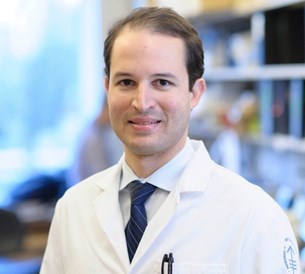Meeting
2022 ASCO Annual Meeting

Instituto do Câncer do Estado de São Paulo, São Paulo, Brazil
Diogo Assed Bastos , Rafael Coelho , Leonardo Cardili , Felipe Galiza , Eder Nisi Ilario , Públio Viana , Claudio Bovolenta Murta , Giuliano Guglielmetti , Mauricio Cordeiro , Jose Pontes Jr , David Queiroz Borges Muniz , Jamile Almeida Silva , Jose Mauricio Mota , Guilherme Fialho de Freitas , Katia Ramos Moreira Leite , Carlos Alberto Buchpiguel , William Carlos Nahas
Background: Patients (pts) with high-risk localized prostate cancer (HRLPC) have a significant risk of disease recurrence and metastasis after radical prostatectomy (RP). Neoadjuvant therapy remains investigational but there may be a role for the next-generation androgen signaling inhibitors. We sought to evaluate pathologic and imaging response after the intense neoadjuvant approach. Methods: This is a phase II investigator-initiated randomized trial of 3-month neoadjuvant therapy with goserelin (androgen deprivation therapy, ADT) + abiraterone acetate and prednisone (AAP arm) or AAP + apalutamide (A-APA arm) before RP for pts with HRLPC (Gleason ≥ 8 and/or cT3N0-1 and/or PSA ≥ 20 ng/mL). The primary endpoint was the rate of pathologic complete response (pCR) or minimal residual disease (MRD, tumor ≤ 0.5 cm). The secondary endpoints were safety, rate of residual cancer burden ≤0.25 cm3 (RCB = tumor volume x cellularity), Gallium 68 prostate-specific membrane antigen (PSMA) positron emission tomography (PET)/magnetic resonance correlates and rate of biochemical relapse (BR). Results: Sixty-two pts were randomized to A-APA (N = 31) or AAP (N = 31). Median age was 65 (range 47-77) years. NCCN risk groups included high-risk disease in 19%, very high-risk in 76% and regional (N1) disease in 5% (79% cT3, 65% Gleason 8-10, 57% PSA ≥ 20 ng/mL). Outcomes after intense neoadjuvant ADT are described in the Table. There was no statistically significant difference between study arms regarding pCR/MRD or RCB ≤ 0.25 cm3 rates. Patients with complete PSMA-PET response (psmaCR) demonstrated a RCB ≤ 0.25 cm3 rate of 50% compared to 7.5% in pts without a psmaCR (P= 0.001). The rate of BR was 14% for pts with RCB ≤ 0.25 cm3 versus 38% in pts with RCB > 0.25 cm3 (P= 0.118). At current median follow-up of 2.6 years, all patients with both psmaCR and RCB ≤ 0.25cm3 (N = 11, 18%) are free of BR. There were 2 grade (G) 5 adverse events (AEs) in the AAP arm (pulmonary embolism and sudden death, both after surgery). Nine (14.5%) pts (6 in A-APA; 3 in AAP) experienced G3-4 treatment-related AEs. The most common G3-4 AEs were hypertension (11.3%), AST/ALT elevations (3.2%) and skin rash (1.6%). Conclusions: No difference in pCR or MRD was observed between arms. Although pCR or MRD after intense neoadjuvant ADT was infrequent, a significant proportion of pts achieved a favorable pathologic response with RCB ≤ 0.25 cm3. PSMA-PET response is a potential surrogate for pathologic response. Clinical trial information: NCT02789878.
| A-APA (N = 31) | AAP (N = 31) | P value | |
|---|---|---|---|
| Complete PSMA response | 15 (48%) | 7 (23%) | 0.034 |
| pCR or MRD | 1 (3%) | 2 (7%) | 0.554 |
| ypT2N0 | 12 (39%) | 8 (26%) | 0.227 |
| ypT3 | 19 (61%) | 22 (71%) | 0.421 |
| ypN1 | 6 (20%) | 7 (23%) | 0.755 |
| Positive margins | 8 (26%) | 12 (39%) | 0.277 |
| RCB ≤ 0.25m3 | 10 (32%) | 4 (13%) | 0.068 |
| Testosterone recovery | 29 (94%) | 26 (84%) | 0.425 |
| Biochemical relapse | 10 (32%) | 10 (32%) | 1.0 |
Disclaimer
This material on this page is ©2024 American Society of Clinical Oncology, all rights reserved. Licensing available upon request. For more information, please contact licensing@asco.org
2022 ASCO Annual Meeting
Poster Session
Genitourinary Cancer—Prostate, Testicular, and Penile
Genitourinary Cancer—Prostate, Testicular, and Penile
Prostate Cancer–Local-Regional Disease
NCT02789878
J Clin Oncol 40, 2022 (suppl 16; abstr 5085)
10.1200/JCO.2022.40.16_suppl.5085
5085
268
Abstract Disclosures
2023 ASCO Annual Meeting
First Author: Tian Zhang
2024 ASCO Genitourinary Cancers Symposium
First Author: Ahmed M. Mahmoud
2024 ASCO Genitourinary Cancers Symposium
First Author: Jose Mauricio Mota
2024 ASCO Genitourinary Cancers Symposium
First Author: Junlong Zhuang